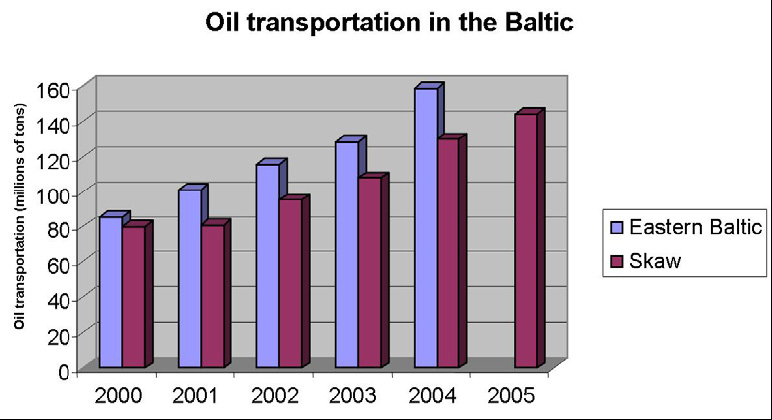Press release
HELCOM releases latest statistics on ship traffic in the Baltic Sea
Helsinki, 3 August (HELCOM) – More than 50,000 vessels annually pass the Skaw at the northernmost tip of Denmark on their way into or out of the Baltic, according to the latest statistics provided by the new HELCOM Automatic Identification System (AIS) for monitoring maritime traffic in the Baltic Sea area.
“The HELCOM AIS system, which was officially launched on 1 July 2005, is providing, for the first time ever, a possibility to get an up-to-date and comprehensive overview of the ships’ traffic situation in the Baltic Sea area,” says Anne Christine Brusendorff, HELCOM Executive Secretary.
During the past twelve months to July 2006, around 51,600 ships entered or left the Baltic via the Skaw, about 51,000 passed the Swedish island of Gotland, and more than 37,000 entered/left the Gulf of Finland.
Approximately 60-70% of these ships were cargo vessels, and 17-25% were tankers. There are about 1,800 - 2,000 ships in the Baltic marine area at any given moment. Vessels with a draught less than 7 meters constitute the biggest part of the ships entering/leaving the Baltic via the Skaw.
The reporting lines of HELCOM AIS showing spatial distribution of shipping activities can be seen on the map below. (Click here for a larger size map.)
.jpg)
The available data also indicates that both the number and size of the ships (especially oil tankers) have been growing during last years and now ships carrying up to 150 thousand tonnes of oil can be seen in the Baltic. Also the amount of transported oil has increased significantly since the year 2000 (Figure 1).

Figure 1. Amount of oil transported via 11 largest oil terminals in the East Baltic (Gdansk, Klaipeda, Ventspils, Muuga, Primorsk, Porvoo, Naantali, Riga, Butinge, St. Petersburg and Kaliningrad) and via the Skaw (in millions of tonnes)
The HELCOM AIS system enables the identification of the name, position, course, speed, draught and cargo of every ship of more than 300 gross tonnes sailing in the Baltic Sea, and displays all the available data over a common background map of the region.
The system covers the whole of the Baltic Sea and Norwegian waters. It greatly improves risk management and facilitates decisions on new measures to prevent collisions and improve navigational safety in the Baltic Sea.
The system includes land-based stations established in all the coastal countries to receive information from all vessels passing through their national waters. All stations are linked to a special "HELCOM server", which combines all the data and provides a comprehensive real-time picture of the overall maritime traffic situation in the Baltic Sea to the competent authorities in each HELCOM member state. The server updates ships’ positions every six minutes.
In addition to providing shore stations with information, the AIS also enables ships to detect and identify each other at sea. The AIS messages contain information on the identity, position and course of the vessel, as well as various additional data.
The primary task of the shore-based AIS network is to provide the competent authorities with a monitoring tool for supervision, risk analyses, search and rescue (SAR) operations, port state control, security and other safety-related tasks to ensure safe navigation in the crowded waters of the Baltic Sea.
The HELCOM AIS network also makes it possible to elaborate statistics on the nature and extent of shipping, as well as the amounts of cargo being transported in the Baltic Sea area. This will provide an improved basis for future risk assessments and the identification of needs for additional measures.
The decision to establish a land-based monitoring system for ships, based on AIS signals, was agreed during the HELCOM Extraordinary Ministerial Meeting in Copenhagen in 2001, which closely followed one of the most serious oil spills in the Baltic in recent years. On 29 March 2001, close to the sea border between Germany and Denmark, the double-hulled oil tanker “Baltic Carrier” collided with the bulk carrier “Tern”, resulting in the spillage of 2,700 tonnes of heavy fuel oil, much of which eventually washed up along the Danish coast.
The new system builds upon the International Maritime Organisation’s (IMO) requirements for all larger ships to be equipped with AIS. HELCOM’s work will also contribute at European level to the implementation of the EU directive on traffic monitoring and information, under which AIS exchange systems should be operational by the end of 2008.
For more information, please contact:
Mr. Tadas Navickas
Professional Secretary
Tel: +358 (0)207 412 642
Fax: +358 (0)207 412 639
E-mail: tadas.navickas@helcom.fi
Mr. Nikolay Vlasov
Information Secretary
Tel: +358 (0)207 412 635
Fax: +358 (0)207 412 639
E-mail: nikolay.vlasov@helcom.fi

